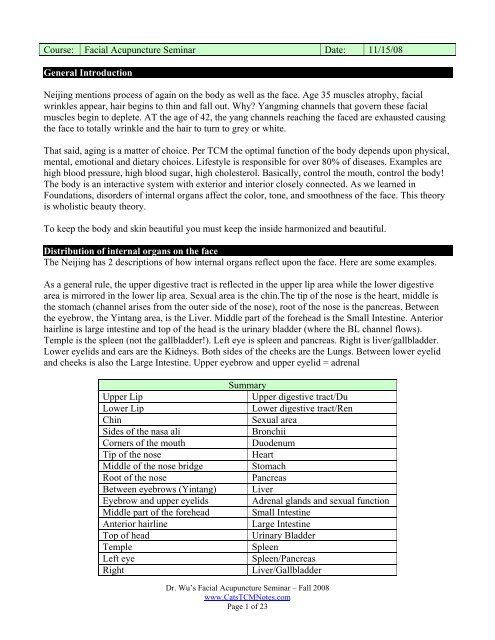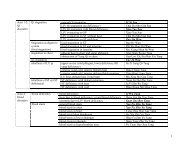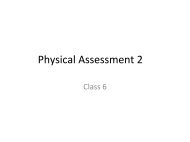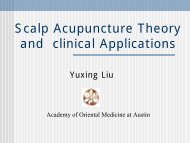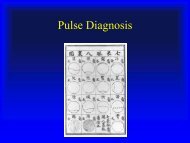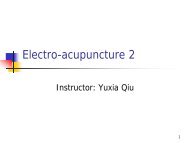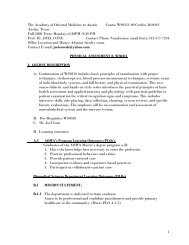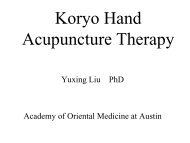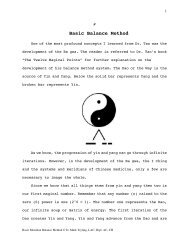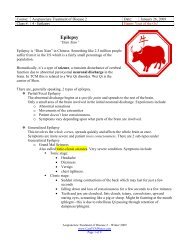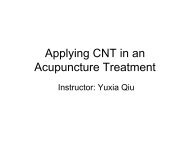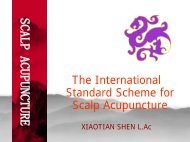Facial Acupuncture Seminar Notes.pdf - CatsTCMNotes
Facial Acupuncture Seminar Notes.pdf - CatsTCMNotes
Facial Acupuncture Seminar Notes.pdf - CatsTCMNotes
You also want an ePaper? Increase the reach of your titles
YUMPU automatically turns print PDFs into web optimized ePapers that Google loves.
Course: <strong>Facial</strong> <strong>Acupuncture</strong> <strong>Seminar</strong> Date: 11/15/08<br />
General Introduction<br />
Neijing mentions process of again on the body as well as the face. Age 35 muscles atrophy, facial<br />
wrinkles appear, hair begins to thin and fall out. Why Yangming channels that govern these facial<br />
muscles begin to deplete. AT the age of 42, the yang channels reaching the faced are exhausted causing<br />
the face to totally wrinkle and the hair to turn to grey or white.<br />
That said, aging is a matter of choice. Per TCM the optimal function of the body depends upon physical,<br />
mental, emotional and dietary choices. Lifestyle is responsible for over 80% of diseases. Examples are<br />
high blood pressure, high blood sugar, high cholesterol. Basically, control the mouth, control the body!<br />
The body is an interactive system with exterior and interior closely connected. As we learned in<br />
Foundations, disorders of internal organs affect the color, tone, and smoothness of the face. This theory<br />
is wholistic beauty theory.<br />
To keep the body and skin beautiful you must keep the inside harmonized and beautiful.<br />
Distribution of internal organs on the face<br />
The Neijing has 2 descriptions of how internal organs reflect upon the face. Here are some examples.<br />
As a general rule, the upper digestive tract is reflected in the upper lip area while the lower digestive<br />
area is mirrored in the lower lip area. Sexual area is the chin.The tip of the nose is the heart, middle is<br />
the stomach (channel arises from the outer side of the nose), root of the nose is the pancreas. Between<br />
the eyebrow, the Yintang area, is the Liver. Middle part of the forehead is the Small Intestine. Anterior<br />
hairline is large intestine and top of the head is the urinary bladder (where the BL channel flows).<br />
Temple is the spleen (not the gallbladder!). Left eye is spleen and pancreas. Right is liver/gallbladder.<br />
Lower eyelids and ears are the Kidneys. Both sides of the cheeks are the Lungs. Between lower eyelid<br />
and cheeks is also the Large Intestine. Upper eyebrow and upper eyelid = adrenal<br />
Upper Lip<br />
Lower Lip<br />
Chin<br />
Sides of the nasa ali<br />
Corners of the mouth<br />
Tip of the nose<br />
Middle of the nose bridge<br />
Root of the nose<br />
Between eyebrows (Yintang)<br />
Eyebrow and upper eyelids<br />
Middle part of the forehead<br />
Anterior hairline<br />
Top of head<br />
Temple<br />
Left eye<br />
Right<br />
Summary<br />
Upper digestive tract/Du<br />
Lower digestive tract/Ren<br />
Sexual area<br />
Bronchii<br />
Duodenum<br />
Heart<br />
Stomach<br />
Pancreas<br />
Liver<br />
Adrenal glands and sexual function<br />
Small Intestine<br />
Large Intestine<br />
Urinary Bladder<br />
Spleen<br />
Spleen/Pancreas<br />
Liver/Gallbladder<br />
Dr. Wu’s <strong>Facial</strong> <strong>Acupuncture</strong> <strong>Seminar</strong> – Fall 2008<br />
www.CatsTCM<strong>Notes</strong>.com<br />
Page 1 of 23
Lower eyelids and ears<br />
Both sides of cheeks<br />
Between lower eyelid/cheek<br />
Kidney<br />
Lungs<br />
Large Intestine<br />
How does this help Locations of problems on the face indicate locations of problems in the body as<br />
reflected in the face. Acne for instance if located on forehead reflects a Large Intestine problem. Acne<br />
here is heat in the Large Intestine. Constipation may follow! Then bad odor in the mouth and other<br />
lower digestive problems. This patient will likely have similar acne around the mouth. Moral to the<br />
story: the location of the acne/other problems tells a lot of secrets about the internal organs. The face is<br />
the book upon which our health is written!<br />
The Three Ting<br />
Ting means “courtyard”. The Three Tings are areas A, B, and C, also referred to as Upper, Middle, and<br />
Lower Ting. Divide the face into these 3 areas and compare the sizes—a person with one larger than<br />
other may have strengths in the largest areas. Smaller areas may reflect weaknesses. This could also<br />
indicate possible imbalance. For instance, someone with a large upper ting might be very intelligent, but<br />
that could impact other areas negatively because they live in their heads!<br />
Upper Ting<br />
This is area B on the diagram. This area includes the forehead and the periphery of the forehead<br />
and includes the temples and eyebrows. This area represents the condition of the nervous system<br />
as a whole. Mental, nerve, and intelligence area.<br />
Middle Ting<br />
This area is area C on the diagram. This reflects the condition of the circulatory and excretory<br />
systems. These are athe side facial areas including eyes, cheeks, and ears.<br />
Lower Ting<br />
Area A on the diagram. The conditions of the mouth, lips, tongue, mouth cavity and areas around<br />
the mouth relate to the digestive functions of the body and also partially relates to the respiratory<br />
functions, especially in the peripheral areas of this zone.<br />
Brief History of TCM for Face Lifting<br />
Dates back to the Tang Dynasty, the 7 th Century AD. Tang Dynasty was an era of great prosperity and<br />
had the luxury of beauty. Face lifting skills have been developed to improve overall health which had<br />
the happy side effect of reducing the signs of ageing.<br />
In 1974 the Chinese government, at the end of the Cultural Revolution, blessed the birth of Cosmetic<br />
<strong>Acupuncture</strong>. This is about 2 years after Nixon visited China. In 1989 Dr. Wu published a book along<br />
with some colleagues regarding “beautyculture” which was one of the first textbooks systematically<br />
discussing acupuncture and Chinese medicine and it’s effects on beauty culture. (Practical Application<br />
of <strong>Acupuncture</strong> and Chinese Medicine for Beautyculture, Dr. Jamie Wu, 1989.)<br />
This weekend’s schedule:<br />
Dr. Wu’s <strong>Facial</strong> <strong>Acupuncture</strong> <strong>Seminar</strong> – Fall 2008<br />
www.CatsTCM<strong>Notes</strong>.com<br />
Page 2 of 23
Saturday morning (start at 9:30):<br />
<strong>Facial</strong> evaluation methods<br />
Includes problems of the face, blemishes, sunburns, etc.<br />
Saturday afternoon (start at 1:30):<br />
Chinese herbs (topical/linaments/lotions) and tuina<br />
Be aware that some herbs applied topically can cause blisters and scars.<br />
Sunday morning (start at 9:30):<br />
Bring a travel kit! <strong>Acupuncture</strong> techniques and demonstration, practice basic skills<br />
What to buy for tomorrow:<br />
Seirin #1, 0.16mm (Japanese gauge 1, Chinese gauge 40), ½ cun or 1 cun (both<br />
best)<br />
0.18’s are too big – leaves holes and bleeding<br />
Sunday afternoon (start at 1:30):<br />
Practice advanced skills in a clinic like setting, quiz taking.<br />
Dr. Wu’s <strong>Facial</strong> <strong>Acupuncture</strong> <strong>Seminar</strong> – Fall 2008<br />
www.CatsTCM<strong>Notes</strong>.com<br />
Page 3 of 23
Part One <strong>Facial</strong> Evaluation<br />
<strong>Facial</strong> Skin Types<br />
Skin types are related to environment in which you live, congenital constitution (and lingering fetal<br />
toxins…common in China to give herbs to a newborn to release these fetal toxins which results in less<br />
constitution, hemorrhoids, and acne later in life). Look at the skin overall when you evaluate.<br />
Normal facial skin - Balanced<br />
Moist, plump, dewey. Sweating pores are small to medium and not clearly visible. No blemishes,<br />
no or few sunburns. Soft, firm, smooth and with good elasticity. This is balanced, harmonized<br />
skin.<br />
People who live in humid environments have a better chance of having this kind of skin. Eating a<br />
lot of soy products will also help with this – natural estrogen source.<br />
Described as “peach flower” which is light peach color coming from deep inside the face.<br />
Oily facial skin - Overactive<br />
Pores are more visible/noticeable than other types – coarse, medium to large sized pores. This<br />
allows the oil to come out easily. Their appearance is shiny. Skin is thicker, firmer, less sensitive<br />
than other types. Most often seen between 12 – 22 years, though some people have it throughout<br />
life. Why Hormones are higher at this period of time. Less sensitivity to topical applicatons and<br />
tuina on the face. More likely to have blocked pores and blemishes such as acne. Aloe mask can<br />
help with this…more later.<br />
A one-word description for this type would be “overactive”. Therefore, you can use stronger<br />
stimulation for this type.<br />
Dry facial skin - Underactive<br />
Opposite of oily skin. There are several types which may happen in combinations:<br />
Lack of oil – simple dry skin<br />
Sweating pores are small and skin is thin. Oil cannot come out.<br />
Lack of water – dehydrated<br />
Sweating pores are larger, skin is thick<br />
This type is underactive and needs more tonification.<br />
Combination Skin - Assymetrical<br />
The “T Zone” which encompasses the forehead, nose and chin, is often oily while the cheeks and<br />
eye area are normal or dry. 95% of people fall into this category. Another 5% will have<br />
blemishes in the T zone and no problems in the other areas. Might also see T zone normal with<br />
the cheeks/eye dry.<br />
This type is not harmonized, so you must use a balancing treatment.<br />
Dr. Wu’s <strong>Facial</strong> <strong>Acupuncture</strong> <strong>Seminar</strong> – Fall 2008<br />
www.CatsTCM<strong>Notes</strong>.com<br />
Page 4 of 23
Sensitive Skin - Delicate<br />
Pay most attention to this type of skin. Overaction to external influences. This type is easily<br />
irritated by sun exposure, chemicals/cosmetics, handling, have tendency to broken capillaries.<br />
Can easily get skin allergies as well.<br />
Other skin types can also be sensitive skin types. This is related to body constitution. Celtic<br />
descent patients are more prone to sensitive skin. Look for blue eyes, blonde or red hair, fair<br />
skin. If you needle the skin around the needle will get red quickly. This is familial/congenital<br />
related. More superficial nerve endings, capillaries, and blood vessels. Strong, quick reaction to<br />
stimulation because the Wei qi reacts quickly…they may also get better results to body needling!<br />
However, on the face, this strong reaction may result in a bruise/ hematoma. Also, topical<br />
application of herbs may cause skin burns, blisters.<br />
Treat these patients with caution.<br />
Aging <strong>Facial</strong> Skin - Inactive<br />
All facial skin types can also be … will be! … aging as well. Visible signs of aging appear<br />
starting at the age of 30. By 40 years old the pigmentation cells and immune cells in the skin<br />
decrease. Sunshine will cause sunburn more quickly now. Expression/laugh lines deepen, aging<br />
spots appear. After 50 years old the oil gland activity significantly declines – more sensitivity to<br />
weather changes and climate changes. Lines, wrinkles and sagging due to poor elasticity begin to<br />
show.<br />
A note about aging and wrinkles: if wrinkles on the forehead disappear with facial paralysis, then<br />
the patient is suffering from Bell’s Palsy. If the wrinkles on the forehead stay with facial<br />
paralysis then it is Central <strong>Facial</strong> Paralysis. Also, eyebag on one side and not on the other<br />
indicates paralysis of either kind.<br />
Since this skin is inactive, you tonify, moisten, nourish.<br />
<strong>Facial</strong> Color with Skin Blemishes<br />
Red Coloring<br />
Red can indicate<br />
1) Yang rising<br />
2) Invasion of external pathogen<br />
a. Wind heat comes from weather changes<br />
b. Toxic heat from comes from the sun.<br />
Toxic heat leads to cancer. For that matter, if you leave a bottle of water in your car the<br />
heat of the sun can toxify it and you shouldn’t drink it. In this part of the country, avoid<br />
the sun between 9am and 3pm for least toxicity.<br />
3) Retention of internal heat.<br />
Typical facial skin problems which are more external/excess include but are not limited to:<br />
Acne<br />
Dr. Wu’s <strong>Facial</strong> <strong>Acupuncture</strong> <strong>Seminar</strong> – Fall 2008<br />
www.CatsTCM<strong>Notes</strong>.com<br />
Page 5 of 23
Sunburns<br />
Phytophotodermatitis is included. The nose is often affected first (the King of the Face)<br />
Urticaria<br />
Butterfly skin rash due to lupus<br />
This “rash” is across the nose and the cheeks and is somewhat butterfly shaped across the face.<br />
This is systemic lupus erythematosus. These patients should get less exposure to the sun as this<br />
will exacerbate the problem.<br />
Rosacea<br />
Brandy nose<br />
Black Color<br />
Includes aging spots, brownish or blackish. Can indicate yin or essence deficiency. Pregnancy can cause<br />
skin discolorations when the baby gets the essence and leaves the mother deficient. This also includes a<br />
bluish-dark blackish overall complexion color to the skin. Typical problems include:<br />
Aging spots<br />
Blood, yin and essence has waned causing dark spots.<br />
Senile plaque<br />
Sun spots<br />
Darkness of eyelids<br />
Melasma<br />
(dark brown symmetrical patches of pigment on face)<br />
Suprarenale (Addison’s disease)<br />
Chronic acne with blackheads<br />
Sign of body fluid deficiency. Toxic heat to body fluid comes first, muscles erode, final step is<br />
the blackhead.<br />
White Color<br />
Indicates Qi and Blood deficiency. Look for a pale face. Happens post-preggers often. Can also happen<br />
to women who lose a lot of blood in menses. You might see people with a bright white complexion<br />
color.<br />
Vitiligo<br />
In biomed this is the loss of melanocytes. In TCM this is loss of qi/blood and thus deficiency.<br />
Need to reduce exposure to sunshine.<br />
Anemia<br />
Heavy menstrual bleeding<br />
Chronic diarrhea<br />
Chronic colitis<br />
IBS<br />
Post partum depression syndrome<br />
Miscarriage<br />
Abortion<br />
Hypotension<br />
Dr. Wu’s <strong>Facial</strong> <strong>Acupuncture</strong> <strong>Seminar</strong> – Fall 2008<br />
www.CatsTCM<strong>Notes</strong>.com<br />
Page 6 of 23
Yellow and Brown Color<br />
Indicates 1) blood xu, 2) spleen xu, 3) dampness retention. Women who have profuse vaginal discharge<br />
may have damp retention and thus the yellow/brown coloring. Heavy menstruation and irregular menses<br />
might also express with this complexion. Patients with anemia/blood xu may also manifest a yellow<br />
and/or brown color.<br />
Typical examples:<br />
Chloasma<br />
This is different from normal aging spots – chloasma/melasma are larger pieces, can be<br />
symmetrically located (bilaterally), only located on the face. Aging and sunspots are smaller,<br />
never symmetrically located, can be anywhere. Look for size, location, symmetry.<br />
Pregnancy spots<br />
Green Color<br />
Caused by<br />
1) Severe pain due to Liver Qi Yu<br />
2) Liver Wind<br />
3) Cold<br />
Patients with seizures, PMS, dysmenorrhea, irregular menstruation, post partum depression syndrome,<br />
and severe pain may have this green coloration.<br />
Blemishes<br />
Warts are caused by virus – papilloma infection. Plantars warts on the bottom of the foot. If the wart has<br />
a blackhead in the center (called “chicken eyes” in TCM – look for the Chicken Eyes Paste for Plantar’s<br />
warts). <strong>Facial</strong> warts due to Qi yu may go away in 6 months if you treat the stagnation.<br />
Hair problems<br />
Hair problems can be due to blood disorder, blood xu, blood yu, and heat in the blood. Alopecia for<br />
instance can happen suddenly and is a result of blood disorders. Genetic alopecia is familial – male<br />
hormone declines after puberty normally, but in balding individuals the male hormone remains high.<br />
This is an excess type – clear heat and sedate the Yang. The Kidney is involved here.<br />
Conclusion<br />
Overall, the change of anatomical structure is most likely due to Qi disorder: sagging, paralysis, ptosis,<br />
eye bags are due to the decreased liftin function of Qi. Wrinkles can also be the result of emotional<br />
disorder such as over-worry, depression, stress or even over-laughing! This is exacerbated by aging.<br />
Color changes are Yin/Yang disorder, blood and essence disorders.<br />
Dr. Wu’s <strong>Facial</strong> <strong>Acupuncture</strong> <strong>Seminar</strong> – Fall 2008<br />
www.CatsTCM<strong>Notes</strong>.com<br />
Page 7 of 23
Part Two: The Mechanism for TCM Face Lifting.<br />
1) Work on the Qi<br />
a. Tonify Qi – acu and OM can replenish Qi and send nutritents to nourish face.<br />
b. Raise Qi – esp SP Qi to maintain normal loc of soft tiss and 5 sense organs<br />
2) Work on Blood<br />
a. Nourish by improving supply, improve facial tone, increase facial skin elasticity<br />
b. Promote blood circ thru ch/collat<br />
c. Cool blood, remove tox and clean facial skin.<br />
3) Work on BF<br />
Promo and adj water metab<br />
a. ++bf circ, nour and moist fac skin for dry<br />
b. –fluid retention and banish puffy eyes/edema on face<br />
c. – the oily skin and maintain open pores.<br />
4) Work on essence<br />
ac and OM can nour essence which governs birth/grow/dev/develop. This delays essence,<br />
reduces sx of aging of all kinds. This is an anti-gravity technique!<br />
5) Work on local soft tissues<br />
Tuina and Anmo + topical app of herbs can relax facial skin, - wrinkles or tighten facial muscles.<br />
This combats sagging in facial/neck areas. Some tech can also scatter/dissolve scar tissue and<br />
hardness for more even/smoothe facial skin.<br />
Previous surgical facelift can result in scarring that you can help soften with facial acu. Reduces<br />
adhesion.<br />
6) Work on balance of whole body.<br />
Harmonizes the body.<br />
From a biomed perspective:<br />
Stimulates production of collagen/elastin so that face muscle tone and elasticity increases. Also reduces<br />
toxins allowing new collagen fibers to form under wrinkles and erase them. This has changed the<br />
biomed facial theory as it is an internal change, not an external one. Extra benefits include overall health<br />
improvement.<br />
Good results can last 3 – 5 years with monthly maintenance. Need 3 – 6 iterations before best results<br />
show. Combine topical application with body work. Patients may see results even after the first<br />
treatment if facial body work and topical herbs are added to formal acupuncture and herbal treatment.<br />
Dr. Wu’s <strong>Facial</strong> <strong>Acupuncture</strong> <strong>Seminar</strong> – Fall 2008<br />
www.CatsTCM<strong>Notes</strong>.com<br />
Page 8 of 23
Part 3: chinese herbs for face lifting<br />
1) Application protocol<br />
a. Topical application<br />
i. Herbal masks<br />
ii. Herbal steaming theory<br />
iii. Herbal cosmetics<br />
iv. Bath and foot care with herbs<br />
Baths nourish whole body. Foot care includes massage, soak in herbs allowing the<br />
KI to send the Qi up and the Liv to get Qi to face.<br />
b. Internal application<br />
Drink herbs to adjust internal organ funx and vital subst.<br />
Pay attention for topical herbs!<br />
1) overall inspection<br />
If blond/blue/fairskin uh oh<br />
2) Evaluate skin type<br />
Which type does pt have<br />
3) Check allergy hx.<br />
4) Allergy testing<br />
a. Test 1:<br />
Make herbal mixture, apply it somewhere else! Somewhere it won’t show to the public.<br />
Retain 30 minutes up to 24 hours. If you want to apply an herb for 30 minutes, keep the<br />
herb elsewhere 2-3 times longer than that. Send them home with it, tape it in place. Have<br />
them report back. <strong>Facial</strong> skin is very sensitive and reacts faster than other skin . This is<br />
why.<br />
b. Test 2:<br />
Scratch skin on client’s forearm or back and evaluate skin reaction. Use the handle of a<br />
needle – just hard enough to make a white line. If person is very sensitive within 2-3<br />
minutes will get red, swollen, puffy. You will see this clearly. If so, only do tonification,<br />
do not use strong herbs.<br />
By the way, NEVER apply ginger juice to the face at all, not even diluted!<br />
c. Test 3: observe the patient’s reaction to the treatment.<br />
Herbs – topical application<br />
Do these facial treatments and body work first, then do facial acupuncture.<br />
Pearl Powder<br />
For face lifting, 3gm mixed with 1tsp (5ml) milk or eggwhite and applied evenly on face 1-2 x per day.<br />
Functionally this nourishes and moistens the facial skin, removes freckles, sunspots and chloasma.<br />
This is a fine powder. Spread it on the face and do the facial manipulations. This is a microderm<br />
abrasion application.<br />
Good for normal, dry, aged skin. If oily, don’t use milk, but add aloe juice. Mix it with the pearl powder.<br />
You can also use lemon juice to cool and soothe Liver Qi. Great for excesses.<br />
Dr. Wu’s <strong>Facial</strong> <strong>Acupuncture</strong> <strong>Seminar</strong> – Fall 2008<br />
www.CatsTCM<strong>Notes</strong>.com<br />
Page 9 of 23
All white herbs (“bai’s”) are good for the Lung and Skin. Mixing it with milk enhances this.<br />
Xin Ren Powder<br />
30 grams of Xin Ren and egg white. Mix them together and put it on the face and rub, wipe, left<br />
techniques. This is very strong to treat melasma, chloasma.<br />
Functions and indications include removing external wind and nourishing skin, eliminating freckles,<br />
chloasma and senile plague.<br />
Traditionally, xin ren used to remove phlegm, stop cough (because it cleanses impurities), promote<br />
bowel movement. Also has an excellent cleansing function. Can even get tarnish off of metal. In facial<br />
treatment, xin ren is a seed, as is the egg. All seeds nourish essence, nourish yin and build blood.<br />
Nourishes Yin and tightens the skin/removes wrinkles. Make a mask of the mix and keep it on 30<br />
minutes.<br />
Freckles vs. chol/melasma: freckles are freakin’ forever, trust me. They’re with you from childhood.<br />
Also start from the center of the face and spread out evenly/equally. All unlike chloasma.<br />
Honey/Egg White Mask<br />
3 eggs, 1 tsp local honey. Mix honey with egg white and stir the mixture. Apply it evenly on the face<br />
and let it dry naturally. This is a very soft mask. Keep it on for about an hour and apply 1 – 2 times per<br />
day. If patient has oily skin, add lemon juice. Keep it on 30 minutes to an hour.<br />
Honey is very moisturizing. Very good for dry skin. (Caution: raw honey is for sedation, cleansing,<br />
moistening; prepared honey has a tonification function.) This treatment is also good for improving<br />
elasticity, preventing the dryness of facial skin and removing wrinkles.<br />
If patient has sensitive skin, steam it for 5 – 8 minutes, then mix when it cools down. This will kill any<br />
germs.<br />
Two types of facial masks: Hard and Soft<br />
Soft masks are good to cool and nourish. You an use fresh cucumber for a<br />
cool sensation and moistening. The honey/egg white mask above is a soft<br />
mask.<br />
Hard masks on the other hand can be made with something like shi gao. You<br />
have to have fresh stuff or use a solid piece of shi gao you grind down then<br />
mix into a paste, mix in herbal preparations, then apply mask. Leave it on 3 –<br />
5 minutes and it will get hard; leave it on 30 min max. Always protect the<br />
eyebrows and five sense organs when you do this!<br />
Cautions with hard masks:<br />
Make sure pt is not allergic<br />
Make sure the herbs aren’t too strong<br />
Protect the 5 sense organs<br />
Remove immediately if pt has anxiety, fear, mental/emotional<br />
discomfort. Watch for panic attacks.<br />
Dr. Wu’s <strong>Facial</strong> <strong>Acupuncture</strong> <strong>Seminar</strong> – Fall 2008<br />
www.CatsTCM<strong>Notes</strong>.com<br />
Page 10 of 23
NOTE: facial acupuncture requires a LOT of needles. This can make a patient feel very panicky if they<br />
have anxiety.<br />
Another NOTE: you add gypsum to tofu to make it hard enough to cut/fry/cook. That’s why it’s so<br />
freakin’ cold.<br />
Herbal Bath Prescriptions<br />
Use raw herbs!<br />
30 g Bai Sha Sheng – cnx to LU and ST<br />
Moistens LU and stops cough, gen fluid/stop thirst, moisten exterior for dry skin. There’s a south<br />
version and a north version (generates fluids better). Use the north version.<br />
30 g Mai Men Dong<br />
30 g Yin Hua<br />
30 g Tian Hua Fen – moisten/remove heat<br />
30 g Dang Gui – common for face lift, for women. Contains female hormones.<br />
30 g Rose flower<br />
10 g Bai Zhi for yangming superficial areas<br />
5g Wu Mei – external for corns/warts, kill parasites, is antifungal. Sour and thus astringes.<br />
Boil with a large amt water for 30 m. Add 1000 ml of cow milk or goat milk which moistens. Soak yo’<br />
body for 30 minutes.<br />
This nourishes Yin and moistens fluids.<br />
Herbal Foot Care<br />
30 grams each of<br />
o Shu di huang<br />
o Shan yao<br />
o Huang jin<br />
o Dang gui<br />
15 grams each of<br />
o Shan zhu yu<br />
o Jie gen<br />
o Chuang xiong<br />
o Bai zhi<br />
2g salt<br />
Add a large amount of water, boil for 30 minutes. Add 2 grams of salt at end. Put feet in when you can,<br />
which move the herbs into the KI channel. Soak feet as soon as it is cool enough for about 20 – 30<br />
minutes until the heat cools.<br />
Herbal cosmetics<br />
Lu Hui Shuang (Aloe)<br />
Functions and indications include drain fire and guide out accumulation, kill parasites, clear heat<br />
and cool liver. Antifungal fx for pathogenic dermatomycoses. Fresh can be applied directly to<br />
face blemishes.<br />
Zhenzhu Shuang (Pearl Powder)<br />
Smoothes, nourishes, moistens facial skin, induces even tone, dewy and plump skin, prevent and<br />
Dr. Wu’s <strong>Facial</strong> <strong>Acupuncture</strong> <strong>Seminar</strong> – Fall 2008<br />
www.CatsTCM<strong>Notes</strong>.com<br />
Page 11 of 23
treat wrinkles and other facial problems. Do this once or twice daily after you clean the facial<br />
skin.<br />
Huang Qi Shuang Paste<br />
Prevents invasion of external pathogens, lifts facial skin and strengthens Wei Qi. 1 – 3 times<br />
daily after cleaning the facial skin.<br />
Examples of taking oral herbs<br />
Pipaye decoction for clearing Lung heat<br />
Pi Pa Qin Fei Yin including 6g ren shen, 15g pi pa ye, 9g huang lian, 12 g sang bai pi, 9g huang<br />
bai, 3 g gancao. Cook as usual.<br />
Clears heat from the LU and ST for acne and red rashes.<br />
Always add a fresh herb as a guide herb.<br />
Flowers are for the head, pi/peel/skin is for the skin. This is a very classic script for acne – lung<br />
and stomach heat.<br />
Porridge with Red date (Da Zao) for face lifting<br />
Red dates (50g) + 100 g rice. Simmer rice / dates in enough water for 30 m. Eat! Tonifies Wei Qi<br />
and nourishes skin and promotes blood circulation for pale face and wrinkles.<br />
Go to the oriental grocery for the best da zao.<br />
Patent herbs<br />
Ren Shen Yang Rong Pian<br />
Ginseng decoction to tone facial skin. Excellent herbal formula for beauty. Works internally to<br />
create Qi and restore blood, stim circulation, and increase production of collagen/elastin,<br />
moisturizes skin and tones the face.<br />
Jia Wei Xiao Yao Pian<br />
Modified rambling pills dealing with emotional stress, anxiety, anger, nervousness and PMS.<br />
Treats chloasma, melasma, warts, freckles. This cultivates inner calm which leads to inner and<br />
outer beauty.<br />
Da Bu Yin Pian<br />
Provides moisture to the body tissues and improves skin quality by stimulation of the production<br />
of collagen and elastin. Good for smokers, women in menopause who often have dull, dry thick<br />
skin and wrinkles due to LU and KI Yin xu.<br />
Shou Wu Pian<br />
Famous Chinese herb formula for hair growth and prevention of premature graying. Can prevent<br />
hair loss due to stress, hormone irregularities or chemotherapy. Nourishes the source of hair:<br />
blood, bone marrow, LV, KI.<br />
Qi Bao Mei Ran Dan<br />
for premature graying of hair or hair loss, loose teeth, darkness of eyelids d/t KI yin and LV<br />
Dr. Wu’s <strong>Facial</strong> <strong>Acupuncture</strong> <strong>Seminar</strong> – Fall 2008<br />
www.CatsTCM<strong>Notes</strong>.com<br />
Page 12 of 23
lood xu. Also moistens and tones facial skin, promotes collagen and elastin production.<br />
Contains: niu xi, tu si zi, gou qi zi, dan gui, bu go zhi, fu ling, he shou wu.<br />
Part Four: <strong>Facial</strong> Bodywork for Face Lifting<br />
Skills and techniques<br />
Five basic techniques<br />
Methods<br />
Pushing technique<br />
Three sub techniques involved here<br />
o Straight pushing.<br />
Use thumb pad or finger pads starting from Yintang and use straight pushing all the way<br />
up to the hairline from the eyebrow. Start at Yintang, move across the forehead. Use<br />
even, equal pressure all the way through the stroke. Alternate between left and right<br />
hands for this. Don’t want to push too hard (making artificial wrinkles). You can use<br />
linament/ointment and gentle pressure. This treats esp horizontal wrinkles on the<br />
forehead.<br />
o Parting pushing<br />
Start at Yintang and push out to the temple area. Same type technique as above –<br />
even/equal pressure throughout. Do both left and right sides simultaneously. Good for<br />
vertically located wrinkles – “scatters” wrinkles.<br />
(There’s a technique in Dr. Fan’s class where you push from lateral hairlines to<br />
Yintang…don’t do this!!!)<br />
o Pushing with one finger meditation<br />
The most difficult of the 3. Use the side tip of the thumb. You leave the thumb tip in one<br />
place but you wave the hand back and forth smoothly. Make a loose fist as if you were<br />
holding a raw egg with that pressure so you don’t break it!<br />
Wiping manipulation<br />
Do this in a circular motion around a sense organ, most commonly the eyes. Much lighter than<br />
the previous ones. Use the finger pads starting at Yintang, go around the eye across the eyebrow,<br />
around the eye and up the root of the nose. You can also make arcs around the nose or mouth.<br />
Good to remove wrinkles around the eyes and furrows.<br />
Another one good for sagging, wipe upwards sweeps with the whole palm in the sagging area.<br />
Pressing<br />
Use one finger and press directly into the point. Dr. Wu uses his middle finger, braced with the<br />
index finger. You can also sweep with index/middle like a walking motion and every 3 or so<br />
swipes then press the acupoints. 3 foot yangs go from head to foot. This will hold the qi in the<br />
Dr. Wu’s <strong>Facial</strong> <strong>Acupuncture</strong> <strong>Seminar</strong> – Fall 2008<br />
www.CatsTCM<strong>Notes</strong>.com<br />
Page 13 of 23
local areas.<br />
Kneading manipulation/internal rubbing<br />
o Kneading: circular motion but leave your fingers in place. Face lifting/sagging/eye bags.<br />
This rubs under the skin.<br />
o Rubbing: move the fingers around from one skin area to another. Microderm abrasion<br />
Flicking<br />
Like drumming your fingers. Increases elasticity.<br />
Can also use a tens unit at taiyang/gb 1 and st 6 or 7. You can use a tuning fork for this too.<br />
Directions<br />
Circular should go clockwise.<br />
Stroking should go upward.<br />
Frequency: 100-120 x per minute with mild pressure. Never switch from one technique to another<br />
quickly! 2 - 3 minutes each technique minimum.<br />
Application of topical herbs: again, make sure no allergies/rx!<br />
Points for attention:<br />
1) Trim your nails!<br />
2) Don’t apply strong stimulation to the “dangerous triangle” – Yintang to LI 20’s.<br />
3) Do body work and application of herbs first and acupuncture last!<br />
4) If acne, acute inflammation/infection, have open wound, then no body work there! Can definitely<br />
make it worse.<br />
Tuina facial examples<br />
Tuina for removing wrinkles around the eyes<br />
Press and knead BL 1, ST 1, GB 1, 2-3.<br />
<br />
Slow heart rate:<br />
Tuina to Xue Lang point (blood wave). This is a regional point, not a linear one. The point between the<br />
2 heads of the SCM is the Xue Lang. Pushing with one finger meditation. There’s a baroreceptor here.<br />
Do this unilaterally, not bilaterally! Pressing here pushes blood pressure up which triggers the body to<br />
lower the heart rate. The eyes are similar. If you use index/middle fingers to press eyeballs something<br />
similar will happen. Eyeball + Xue Lang points will greatly lower the blood pressure/heart rate. Again,<br />
UNIlateral at one time for both eye and xue lang.<br />
Soundscape for face lifting<br />
Use tuning forks on one side of face at a time where it’s really hard to needle.<br />
Dr. Wu’s <strong>Facial</strong> <strong>Acupuncture</strong> <strong>Seminar</strong> – Fall 2008<br />
www.CatsTCM<strong>Notes</strong>.com<br />
Page 14 of 23
Balance neck with a rolling ball<br />
1) Front and back part of neck are out of balance. Front is too soft and prone to sagging while back<br />
is too tight due to reading/computer.<br />
2) Roll the local area with a jade roller to tighten muscles and skin, remove sagginer and balance<br />
front and back. Jade is fine, smooth, cools, and tonifies. Best jade is icy cold to the touch.<br />
Dr. Wu’s <strong>Facial</strong> <strong>Acupuncture</strong> <strong>Seminar</strong> – Fall 2008<br />
www.CatsTCM<strong>Notes</strong>.com<br />
Page 15 of 23
Part Five: <strong>Acupuncture</strong> for Face Lifting<br />
This is known in Chinese as Zhen Jiu (acu + moxa) Mei (beauty) Rong (culture), so “<strong>Acupuncture</strong> for<br />
Beautyculture”. The techniques are referred to in public media and described to patients as:<br />
<strong>Acupuncture</strong> Facelift<br />
Cosmetic <strong>Acupuncture</strong><br />
<strong>Facial</strong> Rejuvenation <strong>Acupuncture</strong><br />
Seirin needles are mostly used because they are smooth and coated. Beware of needles with metal<br />
handles because the handles are heavy and the facial skin is thin and doesn’t support the needle well.<br />
This can bend the needles. View facial differently than body acupuncture. Skin here is very<br />
supersensitive and nerve endings are very close to the surface. Also, facial acupuncture requires a bunch<br />
of needles. (Note: if you want to try the scary points – bladder 1, li 18, ren 22, etc – and the patient is<br />
willing, let Dr. Wu know and we will do this under supervision.)<br />
Clinical Research on Cosmetic <strong>Acupuncture</strong><br />
IN a clinical study of 300 patients in 1996 as reported in the International Journal of Clinical<br />
<strong>Acupuncture</strong>, 90% had marked beneficial results with onely one course of treatment. That said, it is<br />
recommended that for best results multiple treatments are received. Positive results include better skin<br />
tone and color. As an added benefit, there is an overall body improvement.<br />
<strong>Facial</strong> acupuncture (acupuncture facelift) as been featured in mainstream media in many countries,<br />
including this one, attracting a lot of attention. It’s a popular Hollywood thang to do now, with one<br />
clinic charging $2500 for a 10 course treatment. Damn! Moral to the story: it’s a pretty good living!<br />
Channel distribution on the head and face<br />
Yang channels run superficially<br />
All yangs meet at the head and face, the converging place of Yang. The 3 hand Yangs go to the head,<br />
but the 3 foot Yangs go to the feet…sagging and wrinkles are partially due to Qi descending too much in<br />
the 3 foot yangs.<br />
Points on the face are located superficially because the Yang is at the surface here. Ren 24, as a matter<br />
of fact, is the only Yin point on the face! The more superficially the points are located the more quickly<br />
the results are achieved.<br />
This is referred to as the River Theory. Water courses start small, rivulets and creeks rivers seas.<br />
Where the river is small the flow is faster. Where the volume is large the flow is slower. On the face the<br />
river is small and the stimulation is felt more acutely. (As compared to needling He Sea points where the<br />
body is less sensitive.)<br />
The upshot of this regarding facial acupuncture and the stimulation of the Yang channels:<br />
1) stimulation is stronger, 2) result is quicker.<br />
Yin Channels run deeply, but reach the face via the Sun Luo<br />
Bear in mind that while the Yang channels run superficially, the Yin channels run more deeply in the<br />
body (except the Liver channel which goes to the top of the head)—Qi and blood from Yin is the most<br />
Dr. Wu’s <strong>Facial</strong> <strong>Acupuncture</strong> <strong>Seminar</strong> – Fall 2008<br />
www.CatsTCM<strong>Notes</strong>.com<br />
Page 16 of 23
important energy to hold and support he face, but Yin points cannot be reached from the facial areas<br />
(except Ren 24). Yin channels should be tonified from distal areas, legs, feet, and abdomen. Yin<br />
channels which run deeply rise upward in the body like a fountain and then spray outward in the form of<br />
the Yang channels. This refers to the collateral channels of Yin which join with the Yang meridians via<br />
the Luo Connecting channels. The Fu Luo channels are the superficial collaterals. The Sun Luo are the<br />
“grandchildren” collaterals –branches from branches from branches. These bring the Yin energy up to<br />
the head and spread across the face.<br />
Divergent Channels with their converging points on the head/face/neck<br />
How do they connect The 12 divergent channels – they converge at the superficial Yang channels.<br />
Divergent meridians all go upward mostly passing through the heart in the trunk. Remember from<br />
Foundations that the Yin divergents connect with their Yang paired channels. This is another way in<br />
which the Yin energy reaches and supports the face. This is another way in which this acupuncture is<br />
“antigravity technique.”<br />
Note: Yin puncture for face lifting requires a different technique than<br />
traditional body acupuncture. Insert obliquely with the tip of the needle<br />
pointing to the face.<br />
You need a local/distal point association. The distal association is done via Pattern Diagnosis, but on the<br />
face it is a local treatment to support the face in the area where attention is required. You don’t mess<br />
with deficiencies or excesses on the face. (This is kind of like auricular – you don’t do pattern diagnosis<br />
here, but just needle to support an organ and let it worry about whether it tonifies or sedates.)<br />
(not on the quiz)<br />
Meridians Exit area Converging<br />
UB and Kidney Neck BL 10<br />
GB and LIV Outer Canthus GB 1<br />
remove wrinkles on the sides of the<br />
eyes<br />
ST and SP<br />
Mouth<br />
BL 1 and tongue<br />
(small wrinkles around<br />
the mouth)<br />
SI and HT Face UB 1<br />
SJ and PC Behind the ears SJ 16<br />
another window of sky point along<br />
with SI 16/17<br />
LI and LU ST 12 area LI 18<br />
another window of sky point on the<br />
neck.<br />
All divergents start at big joints. The convergent points are often window of sky points. If you wish to<br />
balance the body, use the window of sky points. Window of sky points balance the head and the trunk.<br />
There is a traffic jam of Qi here because so many channels and nerves and blood vessels flow through<br />
this point. For this reason it also adjusts the emotions.<br />
Dr. Wu’s <strong>Facial</strong> <strong>Acupuncture</strong> <strong>Seminar</strong> – Fall 2008<br />
www.CatsTCM<strong>Notes</strong>.com<br />
Page 17 of 23
The convergent points almost all pass through the heart, so they also adjust the Shen. Another thing<br />
about the converging points is that they spread Yang Qi to superficial areas for immune enhancement.<br />
Characteristics of channels distributed on face<br />
Look at the Gallbladder main channel from GB 1…filled with sharp turns all over the side of the head.<br />
(Migraines can be treated by inserting on the GB turn points to unblock the stuck qi flow.) The shape of<br />
the Stomach channel on the face helps to hold the Qi – curves from ST 1 down the cheek and then up to<br />
the corner of the hairline…the negative is that it can help hold retention of external pathogens. Also,<br />
when Liver Yang rises up, these curves catch the energy and cause more Qi and blood stagnation. This<br />
same stagnation can cause wrinkles on the face.<br />
Strategies for working on channels<br />
1) Tonify yin channels from distal areas to ascend Qi and Blood.<br />
Use oblique insertion with the tip pointing upward to do this!<br />
2) Tonify points on the 3 hand yang channels<br />
Use oblique insertion with the tip pointing upward to do this!<br />
3) Tonify the converging areas of the 12 divergent channels<br />
These bring more Qi to the face/head. This refers to the window of sky points. There is a school<br />
of thought stating that Beautyculture starts from the neck, thus the window of sky treatments.<br />
These plus the convergent points should be used with tonification.<br />
4) Sedate points on the 3 foot Yang channels to stop draining.<br />
BL 1 and ST 1 and GB 1 around the eyes. These points are for dreaming – you want less<br />
dreaming for best sleep and beauty. Sedation here does not refer to standard sedation techniques.<br />
You can also puncture on distal areas to help with sedation.<br />
For best result, use local points on a given channel and a distal point on the same channel. Local<br />
points where there is a problem: don’t retain needles too long or will draw too much Qi to the<br />
area and make the problem worse later. Balance with distal points to spread the energy well. This<br />
is how you unblock a channel – local and distal point association.<br />
<strong>Acupuncture</strong> versus Other Techniques<br />
<strong>Acupuncture</strong> is a very healthy alternative to most other techniques (botox, collagen injections, dermal<br />
fillers, microderm abrasions, chemical peels, etc.). Comparatively, acupuncture has overall improvement<br />
in the body’s condition and lasts longer. Also boat loads cheaper! Does it work as fast No. The<br />
rejuvenation is more subtle and can progressively take years off of the look of the face quite naturally<br />
while improving the patient’s health.<br />
<strong>Acupuncture</strong> is not a replacement for a surgical facelift, but is better for those who fear the effects of<br />
surgery and general anesthesia. Surgical options include an extended period of healing and recovery<br />
from swelling and bruising which is very uncomfortable. Also, post-surgical scar tissues (which are<br />
permanent) contribute to health problems by blocking free flow of vital energy in the meridians.<br />
Surgery cuts the channels, sometimes several at once, especially facial surgeries. Comparatively, there’s<br />
no trauma from acupuncture treatment.<br />
Dr. Wu’s <strong>Facial</strong> <strong>Acupuncture</strong> <strong>Seminar</strong> – Fall 2008<br />
www.CatsTCM<strong>Notes</strong>.com<br />
Page 18 of 23
Needle Selection and Methods<br />
Selection<br />
1 cun to thread for several wrinkles. Dr. Wu recommends the #1 needles by Seirin. Thinner needles have<br />
less pain, but harder to control and insert. Use no needles over 0.18mm! Leaves more bleeding and<br />
holes.<br />
Japanese gauge Chinese gauge MM Handle Color<br />
02 0.12 Dark Green<br />
01 0.14 Lime Green<br />
1 40 0.16 Red<br />
2 38 0.18 Ivory<br />
3 36 0.20 Blue<br />
Methods<br />
Pinch insertion technique<br />
Points on face are very superficial and you need to pinch to insert. This prevents needle going to<br />
deep and going into the membrane covering the bone…lots of pain!<br />
o 1st step: insert perpendicularly and quickly (bypasses the nerve ending before it figures<br />
out what’s happening!)<br />
o 2 nd step: change the direction to oblique or parallel/transverse direction while continuing<br />
to pinch. Why wouldn’t you just insert transversely That’s where the nerve endings are!<br />
You don’t want to be able to see the needle under the skin – high potential for pain and<br />
bleeding/bruising.<br />
Non-tube insertion method<br />
Dr. Wu suggests you do not use a tube. You’re going to be using a truckload of needles – you<br />
don’t have room to be pokin’ tubes around this area or you’re going to hit previously inserted<br />
needles causing startling, facial movement, and thus the movement of all other needles already<br />
inserted.<br />
For the body acupuncture you should insert while twisting but you do not do this on the face.<br />
Non-tube insertion is not about finger power, but about relaxing the wrist. This will give you<br />
more power and a quicker insertion.<br />
You will note that eyebrow areas (GB 14, Yuyao) and scar tissue areas are more difficult to<br />
insert.<br />
Plum flower needling<br />
Not like the 7 star needle! This is 3, 5 or 7 needles to treat blemishes like<br />
chloasma, melasma, etc. Always use an odd number! This scatters,<br />
sedates, moves. Even numbers hold, concentrate and tonify. This is true<br />
not just on the face, but all over the body.<br />
Hold the needle just outside of the border of the blemish, aiming under<br />
the skin to the center of the blemish. Every 120 degrees you insert a<br />
needle. This is also called peripheral insertion. For larger blemishes, use larger number of<br />
Dr. Wu’s <strong>Facial</strong> <strong>Acupuncture</strong> <strong>Seminar</strong> – Fall 2008<br />
www.CatsTCM<strong>Notes</strong>.com<br />
Page 19 of 23
needles spaced evenly around the blemish.<br />
Threading and Row Insertion Technique<br />
1cun needle with normal insertion non-tube and pinching<br />
and run deeper, not from one point to another, but from one<br />
wrinkle to another. Transversely insert. Works especially<br />
well for long wrinkles like forehead and mouth area.<br />
The wrinkles will become much more superficial and<br />
breaks it up into smaller pieces. How many to use Use row insertion technique. Always use<br />
odd numbers. How far apart depends upon the length of the wrinkle. Can be as much as 1 inch<br />
apart for starters. One student in a previous seminar used 15 across a forehead wrinkle.<br />
Other considerations:<br />
Ask clients to please not use cosmetics the day they come for treatment!<br />
Strength of insertion should be gentle and soft stimulation.<br />
Depth should be 0.2 – 0.5 inch for each point.<br />
CNT techniques: clean the insertion site to avoid possible infection due to chemical cosmetics.<br />
Bear in mind that some people are sensitive to alcohol – if that’s the case, just use water to clean<br />
the face and a towel or tissue.<br />
NEVER use alcohol around the eyes such as BL 1!<br />
Always ask patients if they are sensitive to alcohol on the face.<br />
Direction of insertion:<br />
o 5 – 15 degrees oblique insertion (deeper than threading) with tip upwards for facial<br />
wrinkles, sags, eye bags. This is true for body and local points.<br />
o Parallel insertion with needle threading through wrinkles. This is a transverse insertion<br />
working right under the blemish or wrinkles<br />
Duration: keep needles for 30-40 minutes after body work and herbal application<br />
For chronic problems such as Bell’s Palsy use e-stim.<br />
Points for attention<br />
Educate the patient about possible side effects such as bruises/hematoma.<br />
Have the patient sign a consent form! Make sure your consent form includes topical app of<br />
herbs, possible accidents, etc. This is vitally important! Check those forms ALWAYS – if you<br />
want to help others, you have to protect yourself. This is a priority!<br />
Dr. Wu’s <strong>Facial</strong> <strong>Acupuncture</strong> <strong>Seminar</strong> – Fall 2008<br />
www.CatsTCM<strong>Notes</strong>.com<br />
Page 20 of 23
No strong stimulations – no thrusting, twisting, etc. Especially true for skin around the eyes.<br />
Withdrawl: press a cotton ball on the point for all points, especially around the eyes. Press and<br />
hold before, during, and after withdrawl! Hold for 5 – 10 seconds before you check for bleeding.<br />
Medically this is not a deal breaker, but the face is the patient’s presentation to the world –<br />
bruising on the face is a huge red flag in all cultures!<br />
This is a reputation killer for you!<br />
No pricking manipulation – no seven star needles on the face.<br />
No moxibustion on the face – aggravates the Yang too much.<br />
Avoid the arteries. Look before you puncture. Look on the forehead for the greenish or purplish<br />
lines. Use your fingerpads and palpate a little bit. If you needle into the blood vessel patient will<br />
bruise!<br />
Dr. Wu’s <strong>Facial</strong> <strong>Acupuncture</strong> <strong>Seminar</strong> – Fall 2008<br />
www.CatsTCM<strong>Notes</strong>.com<br />
Page 21 of 23
FAQ<br />
What about the teensy needles<br />
These are for the wrinkles/eyebag areas and that’s all. Not deep or strong enough to work. Use<br />
foreceps, short ones if you got ‘em. Don’t click ‘em shut or get the kind that don’t click shut.<br />
You can use a bunch of these on the eye bags if you pinch/insert with forecep.<br />
You also use these for the skin around the mouth for smoker’s lines. Needle @ 90 degree angles<br />
against the lines to break them up. Always point upward where-ever possible.<br />
How long does a treatment take<br />
1 ½ hours. Dr Wu has several rooms going at a time – up to 3 – and staggers them so that while<br />
needles are retained on one, he’s needling another or removing needles.<br />
How to needle Bladder 1<br />
Push the eyeball out of the way with a clean cotton ball or your finger, needle directly above<br />
inner canthus. You have to angle a little bit lateral so you don’t hit the bone. Dr. Wu says you<br />
insert ½ - 0.8 cun and you can retain a little bit.<br />
When to expect results<br />
Depends on severity, gender, age, # and degree of blemishes. On the average 3 – 6 times to see<br />
good/visible results.<br />
What to expect during treatment<br />
Feeling of lifting sensation in the needled area, full sensation, tight feeling. Feel as if eyes are<br />
wider. Might also have more color in the face.<br />
How long do the results last<br />
2 – 5 years with maintenance. Sometimes need another course of treatment (20 treatments).<br />
Maintenance can be once per season, once per months, etc. Depends upon the person.<br />
Frequency and courses of treatment<br />
10 treatments is one course, 3 – 10 (some say 3 – 7) days apart. Thus once per week or twice in 2<br />
weeks. Body needs time for regeneration between treatments.<br />
Who should not have <strong>Facial</strong> Lifting<br />
Easy bruisers – blood platelets below 80K. 100K-300K is normal range. Also, people<br />
taking medications such as cumidin can cause easy bleeding. If just baby aspirin, you can<br />
treat. If they are willing, give them Gui Pi Tang and/or have them eat raw peanuts for<br />
couple of months and retest.<br />
Previous surgical face-liftings.<br />
Scar tissues will cause much resistance<br />
Diabetes<br />
High blood sugar damages blood vessel walls, bleed easily. Too much sugar in the blood<br />
is a buffet for bacteria also.<br />
HIV, Cancer, Over all exhaustion<br />
Preggers. Treat with fewer needles<br />
Dr. Wu’s <strong>Facial</strong> <strong>Acupuncture</strong> <strong>Seminar</strong> – Fall 2008<br />
www.CatsTCM<strong>Notes</strong>.com<br />
Page 22 of 23
Acne with pus and swelling.<br />
Clean the area and use plum needle specifications listed previously.<br />
Acute herpes outbreaks<br />
This can spread the disease.<br />
What do I charge<br />
Some charge $125 for 1.5 hours. You can’t really treat other patients when you are doing facial<br />
acupuncture. 3 pack for $325, 5 pack for $525<br />
Examples of Acu-prescriptions<br />
Row insert for blocking wrinkles/remove wrinkles<br />
o Point: areas above/below wrinkles<br />
o Method: hold very thin and small needles and insert the needles vertically thru the<br />
wrinkles. Retain 30-40 m<br />
Local/Distal point association for facelift<br />
o Primary/local: SJ 23, BL 2, Taiyang, ST 3, LI 20, ST 6, SJ 17<br />
o Secondary/distal: RN 12, LI 4, LI 11, ST 36<br />
o Method: Sedate main points, tonify supplementary points.<br />
o Indication/function: Promote blood circulation and unblock meridians, tonify Qi and<br />
blood, prevent and reduce sagging.<br />
Plum flower insertion for sun spots<br />
o Point: sun spots or chloasma<br />
o Plum flower needling around the spots, 3 – 5 needles in total, depending on size.<br />
o Function/Indication: Regulate Qi and blood, promote circulation and remove facial<br />
pigmented spots.<br />
Ear point pricking for chloasma<br />
o Point: spleen point, endocrine, stomach and subcortex/brain<br />
o Method: once every other day, one point each time. 15 visits is one course of treatment.<br />
When pricking, squeeze the point for one drop of blood and clean it.<br />
o Function: promote circulation/cool blood and remove chloasma/freckles.<br />
Dr. Wu’s <strong>Facial</strong> <strong>Acupuncture</strong> <strong>Seminar</strong> – Fall 2008<br />
www.CatsTCM<strong>Notes</strong>.com<br />
Page 23 of 23


